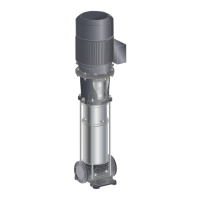English (GB)
20
8. Fault finding the product
DANGER
Electric shock
Death or serious personal injury
- Before starting any work on the product,
make sure that the power supply has
been switched off and that it cannot be
accidentally switched on.
WARNING
Corrosive liquids
Death or serious personal injury
- Wear personal protective equipment.
WARNING
Toxic liquids
Death or serious personal injury
- Wear personal protective equipment.
WARNING
Falling objects
Death or serious personal injury
- Keep the product in a stable and fixed
position when working on it.
CAUTION
Hot or cold liquid
Minor or moderate personal injury
- Wear personal protective equipment.
CAUTION
Hot or cold surface
Minor or moderate personal injury
- Make sure that no one can accidentally
come into contact with hot or cold
surfaces.
Fault Cause Remedy
1. The motor does not
run when started.
a) Supply failure. Connect the power supply.
b) The fuses are blown. Replace the fuses.
c) The motor-protective circuit breaker
has tripped.
Reactivate the motor-protective
circuit breaker.
d) The thermal protection has tripped. Reactivate the thermal protection.
e) The main contacts in the motor-
protective circuit breaker are not
making contact or the coil is faulty.
Replace the contacts or the
magnetic coil.
f) The control circuit is defective. Repair the control circuit.
g) The motor is defective. Replace the motor.
2. The motor-protective
circuit breaker trips
immediately when the
power supply is
switched on.
a) One fuse is blown or the automatic
circuit breaker has tripped.
Replace the fuse or cut in the
circuit breaker.
b) The contacts in the motor-protective
circuit breaker are faulty.
Replace the motor-protective circuit
breaker contacts.
c) The cable connection is loose or
faulty.
Fasten or replace the cable
connection.
d) The motor winding is defective. Replace the motor.
e) The pump is mechanically blocked. Remove the mechanical blocking of
the pump.
f) The motor-protective circuit breaker
setting is too low.
Set the motor-protective circuit
breaker correctly.
3. The motor-protective
circuit breaker trips
occasionally.
a) The motor-protective circuit breaker
setting is too low.
Set the motor-protective circuit
breaker correctly.
b) Low voltage at peak times. Ensure a stable power supply.
4. The motor-protective
circuit breaker has
not tripped, but the
pump does not run.
a) Check 1a, 1b, 1d, 1e and 1f.

